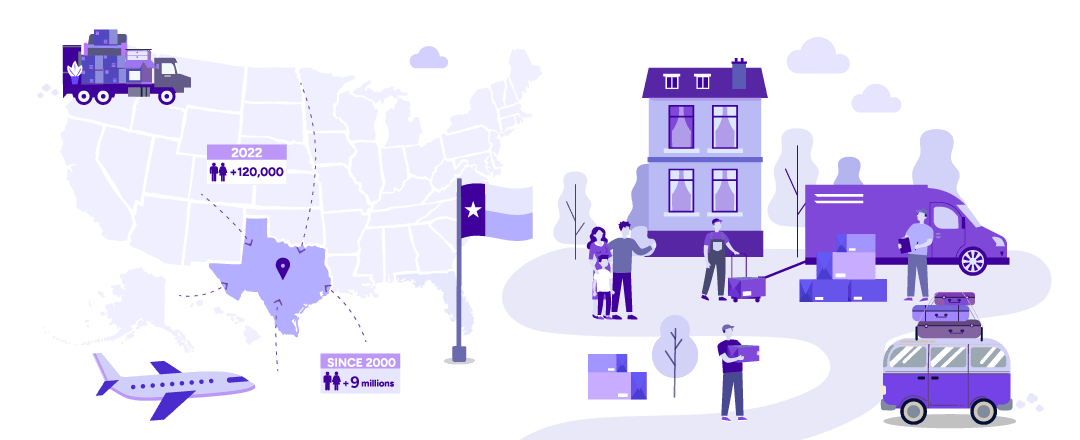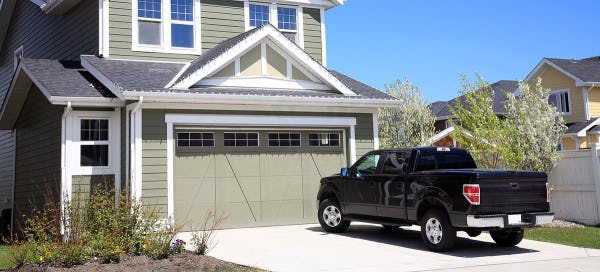Moving to Texas from Arizona: Your Complete Relocation Guide
BREAKING: Texas is humid. Arizona is not. But if you can withstand it, there’s an absolute ton you’ll love about calling the Lone Star State home. Whether you’re seeking a more central location between family members spread across the country, looking for a change in scenery, or simply aiming for a better quality of life, many Arizonans find Texas appealing. The Lone Star State offers diverse landscapes, a booming economy, and an array of communities that fit various lifestyles and budgets. Below is your guide to making a smooth move from Arizona to Texas.
Arizona | Texas | |
Statehood | 48th state, became a state on February 14, 1912. | 28th state, became a state on December 29, 1845. |
Capital | Phoenix | Austin |
Area | 113,990 square miles (6th largest state) | 268,596 square miles (2nd largest state) |
Population | ~7.5 million (2023 estimate) | ~30 million (2023 estimate) |
Climate | Desert climate with hot summers and mild winters. | Diverse, from humid in the east to arid in the west. |
State Bird | Cactus Wren | Northern Mockingbird |
Most Famous Landmark | Grand Canyon | The Alamo |
Major Industry | Copper mining, technology, agriculture | Oil & gas, technology, agriculture |
Why Move to Texas from Arizona?
1. Comparable Cost of Living
While Arizona and Texas have somewhat similar costs of living, Texas offers key advantages. Most notably, there’s no state income tax in Texas, potentially boosting your take-home pay. Rural and semi-rural areas in Texas often provide more affordable housing and land, enabling you to get more space for your dollar than in many rapidly growing parts of Arizona.
2. Central Location for Travel
If you’re currently in Arizona with family in other parts of the U.S., Texas can serve as a strategic midpoint. With major airports in Dallas-Fort Worth, Houston, Austin, and San Antonio, traveling to Florida, the East Coast, or back to Arizona becomes more manageable. Texas’s central location simplifies family visits and holiday trips.
3. Variety of Landscapes and Communities
From the lush pine woods of East Texas to the rolling Hill Country, or the wide-open spaces of North Texas prairies, Texas is far more geographically diverse than many newcomers expect. This diversity also extends to culture and economy. You can choose the hustle of a city suburb or settle into a more tranquil rural community with room for gardening, raising animals, and enjoying wide-open skies.
Choosing Your Ideal Texas Location
1. North and Central Texas for Balance
If you want to avoid extreme weather and still enjoy four distinct seasons, consider Central or North Texas. Areas outside major cities like Waco, Temple, or even semi-rural counties near Dallas-Fort Worth can offer properties under $300,000. Although competition is stiff near metro areas, smaller towns within a 30–45-minute drive from city centers may still have reasonably priced homes with space for a family garden and a few chickens.
2. East Texas for Rich Soil and Rainfall
Gardeners who found Arizona’s climate challenging might welcome East Texas. With richer soil and more consistent rainfall, it’s easier to grow vegetables, herbs, and fruit trees. Many East Texas towns remain more affordable and have a slower pace of life. Check for reliable internet service, though—fiber access is growing, but not universal.
3. The Texas Hill Country for Scenery (But at a Price)
The Hill Country, encompassing areas around Fredericksburg, Kerrville, and New Braunfels, is renowned for its rolling hills, wineries, and quaint towns. However, popularity drives up home prices, making the under-$300,000 range tougher to find. If you’re seeking charm and don’t mind stretching your budget or considering a smaller property, it can be worth exploring.
Navigating Texas Real Estate
1. Start Your Search Early
Texas’s housing market has grown competitive. Begin browsing listings well in advance to identify patterns in pricing and availability. Websites like Zillow, Realtor.com, or local Texas realtor sites can give you a feel for market conditions in different regions.
2. Prioritize Internet Access
If you work remotely or rely on a stable connection, confirm broadband options before committing to a property. Rural Texas can have spotty service, but many areas now have fiber or wireless broadband solutions. Always verify speeds with the ISP or current homeowners.
3. Check Local Regulations and Zoning
If you plan to raise chickens, rabbits, or start a large garden, ensure local ordinances allow small-scale agriculture. Many rural and semi-rural counties have minimal restrictions but double-check to avoid surprises.
Adapting to Texas Weather and Environment
1. Weather Considerations
Texas weather varies widely. North Texas (cities like Temple) and parts of Central Texas can experience severe thunderstorms and occasional tornadoes. Coastal and southeast regions sometimes face hurricanes. While you won’t escape all natural disasters, researching historical weather patterns and investing in a proper storm shelter or insurance can mitigate risks. For the mildest conditions, consider areas just west of major cities or in the Hill Country, where extreme storms are less frequent than in the Panhandle or along the Gulf Coast.
2. Growing Crops and Raising Animals
Thanks to more predictable rainfall in many parts of Texas, you may find it easier to maintain a productive garden than in Arizona. Warm season crops flourish in Texas, and there’s ample opportunity to grow fresh produce for your family. Chickens and rabbits adapt well here, but ensure you have proper shade and ventilation for livestock during hot summers.
Cultural Fit and Lifestyle
1. Embrace the Community Spirit
Texas communities are often tight-knit, friendly, and supportive. Whether you choose a rural town or a suburb near a city, you’ll find neighbors willing to lend a hand, share gardening tips, or recommend local services.
2. Healthcare, Schools, and Amenities
If you’re raising a family, review school districts and healthcare facilities. Many smaller towns are within driving distance of a larger city’s amenities, including hospitals, shopping centers, and entertainment. Proximity to these resources ensures you can enjoy a laid-back home life without sacrificing convenience.
3. Travel and Leisure Opportunities
From day trips to Texas’s historical sites to weekends at inland lakes, coastal beaches, and state parks, Texas offers abundant outdoor recreation. Your new location in Texas can serve as a launchpad for exploring a state that’s brimming with cultural events, festivals, and culinary diversity.

Making the Move Smooth
1. Plan Your Relocation Logistics
Consider hiring a reputable moving company, especially if you’re transporting a home’s worth of items across state lines. Research insurance, request multiple quotes, and schedule your move during milder months to avoid peak summer heat.
2. Explore Temporary Housing Options
If possible, rent before you buy. Renting in a prospective community for a few months can help you confirm whether it meets your lifestyle goals. You’ll gain local insights into traffic patterns, community events, and neighbors before committing to a property purchase.
3. Connect with Local Resources
Use social media groups, forums, or community boards to connect with locals. They can provide firsthand advice on internet providers, farming supply stores, vetted contractors, and more—helping you settle in faster and more comfortably.
4. Familiarize Yourself with the Deregulated Electricity Markets
This is a blog on an electricity company’s website, after all. So we’d be remiss to not give you a heads up that electricity in Texas is deregulated—meaning, you choose who powers your home much like you choose who provides you internet, cell service, and insurance. Not all Texas is, though. Areas around Austin and San Antonio don’t give you the choice, but most of the state, you’ve got the power to choose. So, while we’ve got you, signing up for Rhythm Energy would be the second-best choice you make, right behind making the move to Texas. We offer 100% renewable energy plans, backed by award-winning service and technology that keeps you in control of your energy.
Key Takeaways
Moving to Texas from Arizona can open the door to a richer lifestyle filled with greenery, community spirit, and endless opportunities for homesteading. While you’ll need to do your homework on location, property prices, and weather considerations, the Lone Star State’s diversity ensures there’s a perfect pocket of land and home waiting for you.
Prepare in advance, stay flexible, and look for that sweet spot where property prices, internet access, and climate align with your goals. With the right planning, you’ll find that Texas can feel like home faster than you ever imagined.




